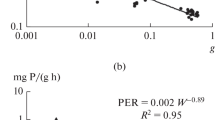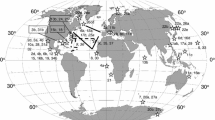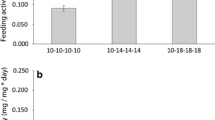Abstract.
Solitary ascidians are the most abundant group of mega-epibenthic animals below 20 m in Potter Cove, King George Island. The present work deals with aspects of growth and respiration to explain this dominance. High growth rates and longevity (maximum ages between 3.1 and 10.6 years) make them effective colonisers after destructive events. Low basal metabolism (between 0.023 and 0.057 ml O2 h–1 per g ash-free dry mass, T=1°C) elevates the scope for growth. These properties, together with other factors, allow these animals to tolerate disturbances better than other filter-feeding groups.
Similar content being viewed by others
Author information
Authors and Affiliations
Additional information
Electronic Publication
Rights and permissions
About this article
Cite this article
Kowalke, J., Tatián, M., Sahade, R. et al. Production and respiration of Antarctic ascidians. Polar Biol 24, 663–669 (2001). https://doi.org/10.1007/s003000100266
Accepted:
Issue Date:
DOI: https://doi.org/10.1007/s003000100266




